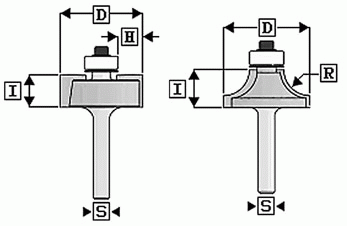This article was reprinted with permission from Wood Tech Tooling, www.woodtechtooling.com.
Router Bit Selection
In this #101 section, we'll cover router bit technical information, terminology and the manufacturing differences that go into making the best router bits on the market.
First is a diagram showing router bit dimensions to help you in determining what bit fits your particular application.

Next is a chart with suggested router bit speeds. Important note: Do not exceed the maximum speed marked on the bit!
| Cutting Diameter (D) | Max. RPM |
| Up to 1" (25.4 mm) | 24,000 |
| 1" (25.4 mm) to 1-1/4" (31.75 mm) | 18,000 |
| 1-1/4" (31.75 mm) to 2-1/4" (57.15 mm) | 16,000 |
| 2-1/4" (57.15 mm) to 3-1/2" (88.9 mm) | 12,000 |
How Quality Router Bits are Produced
Building the best tools starts with using the best raw materials. CMT & Freud excel at adhering to this time honored tradition. Here are just a few of the features that separate them from the rest:
ISO Standards Assure Quality and Consistency:
Both Freud (ISO 9002) and CMT (ISO 9001) apply ISO Common Market Directives and are independently audited for quality control.
Heat Forged Steels:
CMT uses Fatigue Proof® that offers superior strength, uniformity and resistance to fatigue and abrasion. It is chosen by both Porsche and Ferrari to make their engines! Freud utilizes heat forged steel for maximum strength and durability—the same process again used in the automobile industry to produce crank shafts. In comparison, most other manufacturers either turn down cold steel or use die casting. This lower cost method results in a weaker, less durable bit that is prone to breakage.
Superior Grades of Carbide Provide Longer Life and Maximize Finish:
Both CMT & Freud demand only the highest grade Micro- Grain carbides designed specifically for woodworking. Most manufacturers use standard off-the-shelf carbide, which is normally formulated for metal cutting. These carbides dull quickly.
Protective Coatings:
Coatings not only make these bits easily recognizable, they reduce friction and heat build up. Freud uses their exclusive red Perma-Shield™ and CMT their trademark orange PTFE coatings that also prevent adhesion of resins, and protects the bit from corrosion.
Anti-Kickback Design Promotes Safety:
In response to one of the most dangerous hazards in woodworking, both Freud and CMT are leaders in innovative and safe tool design that contribute to a safer working environment. Kickback reducing shoulders reduce overfeeding.
Shear & Hook Angles:
CMT & Freud engineer their bits to “slice” through the wood. This is extremely important when cutting across the grain. Proper shear and hook angles improve the finish and reduce sanding.
This article was reprinted with permission from Wood Tech Tooling, www.woodtechtooling.com.